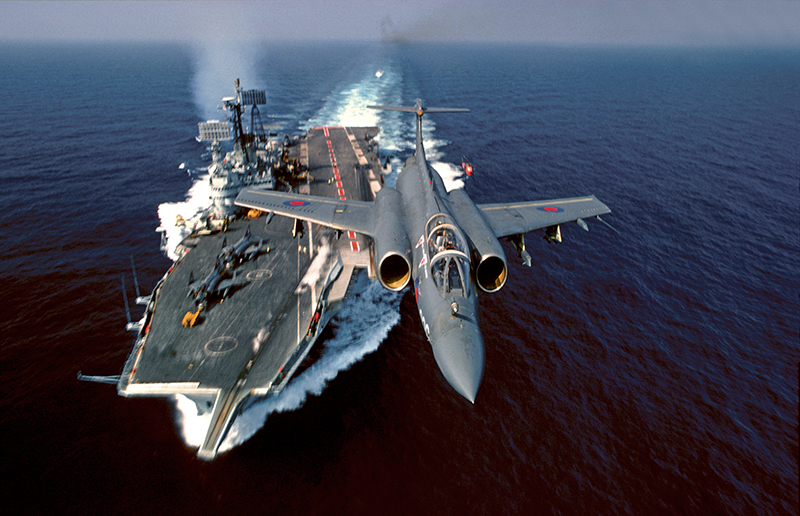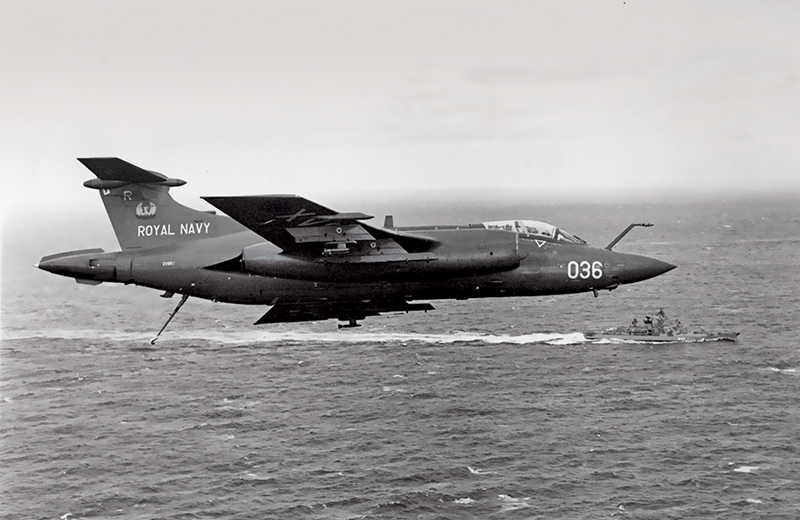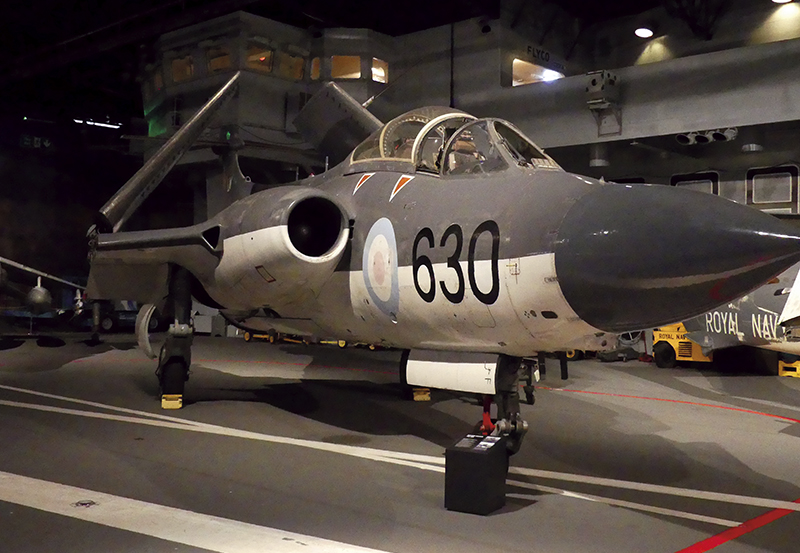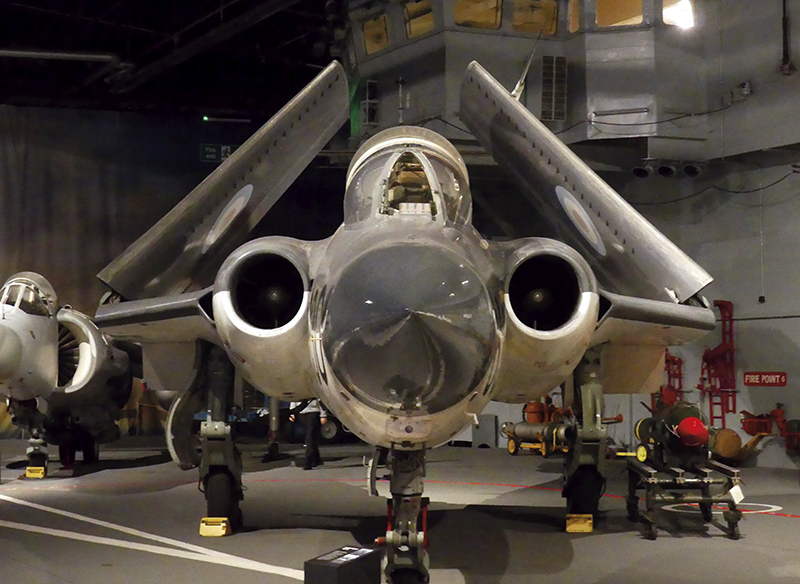Blackburn Buccaneer
In the late 1940’s, the Soviet Union commissioned the Sverdlov class cruiser, a class of 14 ships and the last all gun cruisers built for the Soviet Navy. Designed as a fast fleet screen to work alongside the never-built Stalingrad class battlecruisers and Soviet aircraft carriers, the Sverdlovs weighed in at 16,640 tonnes (16,377 Long tons). They served in both the Soviet and Russian navies and were eventually exported to the Indonesian Navy, remaining in service from 1952 until the turn of the millennium. This class of 210m long, 22m wide and 32.5kts cruisers, with four triple 6in guns, posed a major threat to NATO supply lines, as they had similar commerce raiding capabilities to the German ‘pocket battleships’ of the Second World War. NATO member nations, especially those with limited all weather day/night carrier surveillance and strike capacities, were most as risk. In June 1952, the Admiralty issued Naval Staff Requirement (NSR) NA.39, to design and build a low-level carrier launched maritime strike and attack aircraft. The tender process was won by Blackburn Aircraft in July 1955 and the design entered service as the Blackburn Buccaneer.
Designed with a purpose – During development the project was named the ‘Blackburn Naval Aircraft’ and ‘Blackburn Advanced Naval Aircraft’ in official documents, to keep the project a secret and away from prying eyes. The specification was for a carrier capable, folding wing jet powered strike aircraft with an operational range of 400 nm at speeds exceeding 550 knots at sea level and with a weapons load of 8,000 pounds. It had to capable of deploying the Red Beard free fall nuclear bomb and the in-development Green Cheese anti-ship missile. At Blackburn, Project B-103 was launched with Barry Laight as the designer. Prototype XK486 first flew from RAE Bedford on 30 April 1958 with Derek Whitehead at the controls. What left the (now Hawker Siddeley) factory was an excellent low level, tandem two seater jet strike aircraft with rotating bomb bay, two wing rooted engines and a sliding canopy. By far its most distinctive feature was its laterally deployed bullet fairing air brake.
Built for the job – When attacking its designed target, a Buccaneer equipped with conventional or nuclear bombs would approach the target at 100ft above the sea at 550kts. When 4 miles from the target, it would pitch up to 30 degrees and climb to 1,200ft before releasing the weapon. A harsh pull away would then be performed with a break to the left or right or a half loop before levelling off and descending back to 100ft and accelerating away at 550kts. The escape would have been performed at greater speeds if nuclear weapons were used. Other weapons were an option and could be mounted in the bomb bay or on four wing pylons. A combination of rockets, bombs, fuel tanks and reconnaissance equipment could be carried.
The last British bomber goes to sea – The first production Buccaneer entered service with the Fleet Air Arm in January 1962 and immediately, there was an obvious problem; the engines. Originally equipped with a pair of Gyron Junior engines producing 32,000N of thrust, the Buccaneer S.1 proved to be woefully underpowered and new measures had to be taken to get it off the flight deck. The Buccaneers were loaded with full ordnance but with minimal fuel and the aging and unreliable Supermarine Scimitar would take off ahead of the Buccaneer equipped with buddy refuelling systems. Once airborne, the Buccaneers would top up with fuel from the tanker before carrying on with their missions. By 1965 after several near fatal crashes with the Gyron Junior engines carrying the blame, they were deemed unsafe to fly and withdrawn from frontline service. They were replaced with the Buccaneer S.2, equipped with the significantly more powerful yet more fuel-efficient Rolls Royce Spey turbofan engines that provided 40% more thrust than the Gyron Junior. The two aircraft types can easily be told apart by the circular engine intakes on the S.1 and the more oval shaped intakes on the S.2. Serving from HMS Victorious, HMS Eagle, HMS Ark Royal and HMS Hermes, in a total of six squadrons (700B/700Z, 736, 800, 801, 803 and 809 Naval Air Squadrons), the Buccaneer saw extensive service in the 1960s and the 1970s from show of force flights over British Honduras (modern day Belize), to burning spilt oil off the coast of Cornwall. The latter operation was carried out by Buccaneers from RNAS Lossiemouth when the super tanker Torrey Canyon ran aground and spilled its cargo. The intention of the bombers’ attacks was to disrupt the tanker and ignite the fuel. During its embarked service, the Buccaneer served alongside Scimitars, Sea Vixens, F-4 Phantoms, Gannets, Wessex and Sea King helicopters. The final RN mark was the S2D, modified to carry the Martel missile. By 1978 the Royal Navy had retired its fleet of fixed wing carriers and the Buccaneer was replaced by the Sea Harrier in the strike role from the new V/STOL carriers that came into service in the early 1980’s.
From one branch to the other – Following the cancellation of the TSR2 project, the RAF planned to adopt the American F-111 from General Dynamics. This project also fell through, low-level Canberra bombers needed replacement and the RAF was also required to assume the maritime strike capability from the RN. The Buccaneer was selected and adopted to meet all these needs. 46 new aircraft were built and the FAA’s aircraft were transferred in to the force. The new built aircraft were designated S.2B. Self-defence measures such as chaff, flare and electronic countermeasures were also retrofitted to most aircraft. The addition of Pave Spike laser designators in 1979 allowed for the fleet to designate for fellow Buccaneers, SEPECAT Jaguars and Panavia Tornado. This was put into practice when the Buccaneers served with distinction over the skies of Iraq and Saudi Arabia during the First Gulf War in 1991, flying 218 missions and dropping 48 laser guided bombs including 2 on to Iraqi cargo planes at the Shayka Mazhar airfield. Finally, the aircraft of 208 Squadron were fitted with the new Sea Eagle anti-ship missiles. Following de escalation at the end of the cold war the entire Buccaneer fleet was retired from RAF service in March 1994.
Exportation – The only export customer of the Buccaneer was South Africa. Following the Simonstown agreement, South Africa purchased 16 Spey powered S.2’s which were renamed the S.50 and modified for the hot and high climate at their home air bases. These were equipped with a Rocket Assisted Take-Off (RATO) system courtesy of two Bristol Siddeley BS.605 rocket engines. In the end the system was deemed unnecessary and was removed from all airframes. Serving from 1965 till 1991 they took part in many patrols of South Africa’s vast coastline. They made an integral part of the country’s nuclear deterrent, providing one of the two delivery platforms for their six confirmed nuclear weapons, alongside the Canberra bomber. In the border wars with Angola and Namibia, they carried out ground strikes on armoured targets and covered withdrawing forces.
Arguably, the Buccaneer was one of the most successful and in-the-moment aircraft used by the British armed forces in the cold war environment. Being born over a decade after final decommissioning, I was unable to see this fantastic aircraft fly during its glory days. However, SoFFAAM was lucky to have had a talk in the summer of 2022 by a Buccaneer veteran Graham Pitchfork. This was an insightful talk about the aircraft and its service life. The Fleet Air Arm Museum has three Buccaneers in its collection; Prototype NA.39 (XK488) which is maintained in the Cobham Hall and Buccaneer S.2B (XV333) which was previously on display aboard the carrier exhibit. Buccaneer S.1 (XN957) is the current Buccaneer on display in the refurbished carrier exhibition.
Buccaneer S.2 overflying HMS Ark Royal in the Atlantic Ocean.
© MoD
Buccaneer S.2 overflying a Soviet Kresta Class Cruiser. © MoD
Buccaneer S.1 XN957 on display at FAAM in the refurbished carrier exhibition. © Jozef Newton
The distinctive shape of the Buccaneer S.1 engine intakes are obvious in this photograph. © Jozef Newton




